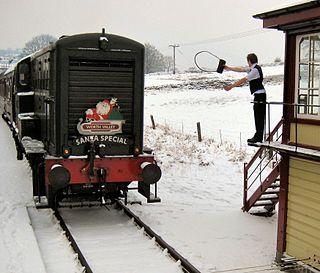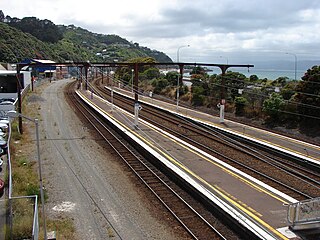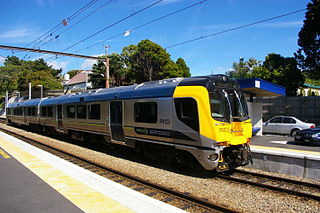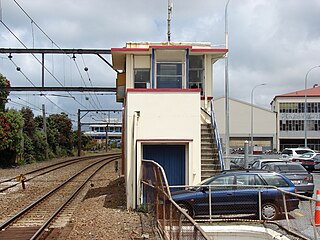Related Research Articles

In railway signalling, a token is a physical object which a train driver is required to have or see before entering onto a particular section of single track. The token is clearly endorsed with the names of the section to which it belongs. A token system is more commonly used for single lines because of the greater risk of collision in the event of a mistake being made by a signaller or traincrew, than on double lines.

William Thomas Locke Travers was a New Zealand lawyer, politician, explorer, and naturalist.
Charles Brown was a New Zealand politician from the Taranaki area.

The North Island Main Trunk (NIMT) is the main railway line in the North Island of New Zealand, connecting the capital city Wellington with the country's largest city, Auckland. The line is 682 kilometres (424 mi) long, built to the New Zealand rail gauge of 1,067 mm and serves the large cities of Palmerston North and Hamilton.

Kaiwharawhara railway station, a former railway station on the North Island Main Trunk and the Wairarapa Line in Wellington in New Zealand, closed in 2013. It was the first station north of Wellington, serving the early suburb of Kaiwharawhara. Prior to its closure it was served by trains operated by Tranz Metro as part of the Metlink network on the Melling Line, the Hutt Valley Line and the Kapiti Line.

Metlink's Kapiti Line is the electrified southern portion of the North Island Main Trunk railway between New Zealand's capital city, Wellington, and Waikanae on the Kāpiti Coast, operated by Transdev Wellington on behalf of Greater Wellington Regional Council. Trains run frequently every day, with stops at 16 stations. Until 20 February 2011 it was known as the Paraparaumu Line.

The Hutt Valley Line is the electrified train service operated by Transdev Wellington on behalf of Metlink on the section of the Wairarapa Line railway between Wellington and Upper Hutt, New Zealand.

The Johnsonville Branch, also known as the Johnsonville Line, is a commuter branch line railway from the main Railway Station of Wellington, New Zealand to the northern suburb of Johnsonville via Ngaio and Khandallah.

Thomas Bannatyne Gillies was a 19th-century New Zealand lawyer, judge and politician.
Tyer's Electric Train Tablet system is a form of railway signalling for single line railways used in several countries; it was first devised in Great Britain by engineer Edward Tyer after the Thorpe rail accident of 1874, which left 21 people dead. It was used in New Zealand for close to 100 years until June 1994. The system used a hard disk called a tablet, a form of token.

The Rakaia railway accident at Rakaia, Canterbury, New Zealand on the evening of Saturday, 11 March 1899 occurred when the second of two excursion trains returning from Ashburton to Christchurch ran into the rear of the first at the Rakaia Railway Station, killing four passengers. While due to excessive speed, the accident resulted in overdue improvements by New Zealand Railways to signalling and braking.
Joseph May was a 19th-century Member of Parliament from the Auckland Region in New Zealand.

Woburn railway station is a suburban railway station serving Woburn and Waiwhetu in Lower Hutt, New Zealand. The station is located on the Hutt Valley section of the Wairarapa Line, 14.4 km (8.9 mi) north of Wellington, and is the junction for the Gracefield Branch to the Hutt Railway Workshops, which diverges eastward from the mainline to the south of the station. Woburn served is by Metlink on behalf of the Greater Wellington Regional Council, with trains stopping at Woburn travelling to Wellington, Taita and Upper Hutt.

Charles Rous-Marten (1842–1908) was a New Zealand journalist and British railway writer and recorder.
Arthur Robert William Fulton a New Zealand engineer was the eldest son of James Fulton and his wife Catherine. Like his brother James, Arthur was a Public Works Department cadet and then an assistant engineer in Westport. He was then asked to join Harry Higginson's practice, where he stayed until 1881, when he went to New South Wales to survey the Goulburn-Cowra section of the Main Southern railway line.

The North–South Junction is a section of single-track rail line about 7 km long, north of Wellington, New Zealand between the closed (2011) Muri railway station and the (lower) Paekakariki railway station to the north. It is part of the Kapiti Line section of the North Island Main Trunk line between Wellington and Auckland, and part of the Wellington–Manawatu Line, built by the Wellington & Manawatu Railway Company (WMR).

The first railway line in New Zealand was the line from Christchurch to Ferrymead opened in 1863. Under the “Grand Go-ahead Policy” of public works instituted by Sir Julius Vogel in 1870 the network was rapidly expanded. Initially lines went from the main town and port to the rural hinterland, but the line between the cities of Christchurch and Dunedin section of the South Island Main Trunk Railway opened in 1878. The New Zealand Railways Department was established in 1876, and the rail network was then run by the central government rather than by provincial governments. Signalling installation was handled by district engineers in the maintenance branch. The Rakaia rail accident in 1899 when four passengers were killed showed the deficiencies in railway signalling and braking; Rakaia did not have fixed signals, and rolling stock apart from locomotives did not have air brakes. But those lines with heavier traffic already had block working installed. The first signalling and interlocking engineer had already been appointed in 1899 at a salary of £400; Arthur H. Johnson, who had “considerable experience in England and America” and who was to design and develop a uniform system of interlocking points and signals. <!—NZ Herald 23 May 1898 --> But he resigned in 1899, and returned to England c1901. He was replaced by Henry John Wynne from 1900; with staff of a chief signal inspector in Wellington and several regional signal inspectors. Wynne retired in 1929. Wynne was replaced by Guy Wilfred Wyles (1887-1947) as Signalling and electrical engineer. Wyles had started with Sykes Interlocking Co in London. He married into Wynn’s family, and died of peritonitis three months before his retirement. The first three engineers all trained in England. Signalling in New Zealand was based on British practice for 60 years until about 1922, when it became “essentially indigenous” – partly British with two-aspect mechanical signalling and partly American with automatic three-aspect signalling using so-called ‘”speed’ indicators.

There are over 3,000 level crossings in New Zealand, with about 1330 being publicly maintained by KiwiRail as of 2013. Of these, 275 crossings were protected by flashing red lights, bells, and half-arm barriers; and 421 are protected by flashing red lights and bells only. The remainder are controlled by "Stop and Give Way" signs. Level crossings are the responsibility of rail infrastructure owner KiwiRail Network, the NZ Transport Agency, and if the crossing is on a local road, the local city or district council. Much like Australia, New Zealand employs American-made crossing warning equipment. There were also in 2013 some 110 stand-alone public pedestrian level crossings; and some private level crossings, which are the responsibility of the land owner.

James Marchbanks was a New Zealand civil engineer. He was Engineer and General Manager for the Wellington and Manawatu Railway Company (WMR) and then the Wellington Harbour Board.
References
- Heine, Richard W. (2000). Semaphore to CTC: Signalling and train working in New Zealand, 1863-1993. Wellington: New Zealand Railway & Locomotive Society. ISBN 0-908573-76-6.
- 1 2 Heine 2000, pp. 14, 15.
- ↑ Heine 2000, pp. 185–98.
- ↑ "Noted Railwayman dies in 86th year". Papers Past. 1950.
- ↑ "Obituary Mr H J Wynne". Papers Past. 1950.